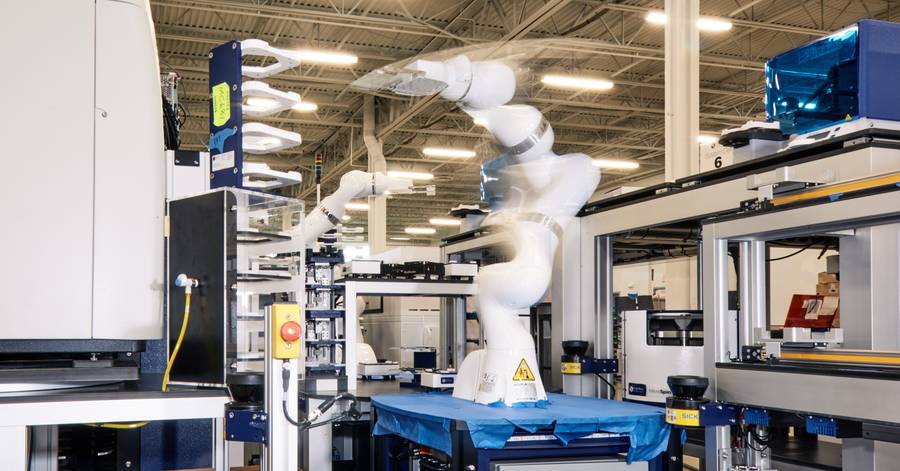Scientists used stem cells to grow a miniature model of a Neanderthal’s brain for the first time. The tiny blob of neurons reveals what makes us different.



A team of researchers from ETH Zurich and the University of Basel in Switzerland and Institut Universitaire de Technologie in France has that found that embryonic kidney cells engineered to produce insulin when exposed to caffeine were able to reduce glucose levels in mouse models. In their paper published in the journal Nature, the group describes their efforts and how well it worked in the mouse models.
People with diabetes suffer from higher than normal levels of glucose in the blood, which can lead to a host of health problems. Current treatments include drugs that make cells more sensitive to insulin, or injection of insulin to make more of it available to cells that need it. In this new effort, the researchers have developed a new way to get more insulin into the body when it is needed most.
Instead of adding insulin externally, the researchers engineered embryonic kidney cells to produce it—but only when they were exposed to caffeine. The team chose caffeine because it has been so extensively studied and because the majority of people consume caffeinated beverages, such as coffee and soft drinks. They point out that caffeine is also a substance that appears very rarely in other foods, making its ingestion easy to regulate. The engineered cells were covered with a material that protected them from the immune system and were then put into a device that was implanted into the abdomens of mice that had been engineered to have diabetes. The researchers note that glucose levels tend to spike after people (and mice) eat sugar or food material that the body converts to sucrose. Thus, the optimal time for giving the mice caffeine would be after eating.
A revolutionary new DNA tool could help take humanity a step closer to eternal life. The device (pictured) pioneers a new technique that makes it cheaper and easier to synthesise genes ‘overnight’, say scientists — a process that normally takes several days.
Scientists at the University of California at Berkeley said it could lead to ‘DNA printers’ in research labs that work like the 3D printers in many modern workshops.
‘If you’re a mechanical engineer, it’s really nice to have a 3D printer in your shop that can print out a part overnight so you can test it the next morning,’ said UC Berkeley graduate student Dan Arlow.

Humanity is made of individuals; preserving the life of individuals preserves humanity. Thus, life extension and the preservation of our species aren’t incompatible.
What is it that really matters: preserving individual lives or preserving humanity? Is it more important to grant individuals the option to live as long as they’d like in good health, or is it more important to ensure the preservation of our species? This sort of question isn’t unheard of in the context of discussions of pros and cons of rejuvenation biotechnology; at times, when presented with the possibility of indefinite lifespans, some people reply that focusing on the preservation of our species is more important. This observation is reminiscent of the “other priorities” objection, and one could respond to it in the same way. However, this issue is also worth examining from other angles.
Quick comeback: the two goals aren’t incompatible
A practical remark to make here is that preserving individual lives automatically preserves the human species because the species only exists as long as there are humans. Not everyone agrees that having a population of individuals that live indefinitely is “good for the species”—be it for fear of overpopulation or of cultural stagnation—but this concept is rather vaguely defined and not objectively measurable. However, here we are stepping into a different territory, one that has been explored in other articles, so we won’t go there in this one.

Companies like Eli Lilly & Co. and GlaxoSmithKline PLC are investing in automation with the hope of transforming drug discovery from an enterprise where humans do manual experiments to one where robots handle thousands of samples around the clock. This automation will be key to developing better therapies more efficiently, drug companies say, as research and development becomes more labor intensive amid the push toward more-tailored…


Eating foods high in salt is known to contribute to high blood pressure, but does that linear relationship extend to increased risk of cardiovascular disease and death? Recent cohort studies have contested that relationship, but a new study published in the International Journal of Epidemiology by investigators from Brigham and Women’s Hospital and their colleagues using multiple measurements confirms it. The study suggests that an inaccurate way of estimating sodium intake may help account for the paradoxical findings of others.
“Sodium is notoriously hard to measure,” said Nancy Cook, ScD, a biostatistician in the Department of Medicine at BWH. “Sodium is hidden—you often don’t know how much of it you’re eating, which makes it hard to estimate how much a person has consumed from a dietary questionnaire. Sodium excretions are the best measure, but there are many ways of collecting those. In our work, we used multiple measures to get a more accurate picture.”
Sodium intake can be measured using a spot test to determine how much salt has been excreted in a person’s urine sample. However, sodium levels in urine can fluctuate throughout the day so an accurate measure of a person’s sodium intake on a given day requires a full 24-hour sample. In addition, sodium consumption may change from day to day, meaning that the best way to get a full picture of sodium intake is to take samples on multiple days.

A group of researchers from Yale University and Agilent Technologies have developed a #syntheticbiology technique that turns bacterium E. Coli into a phosphorylated protein factory capable of churning out every known instance of this modification in human proteins.
Proteins, the end product of genes, carry out life functions. Most human proteins are modified by a process called serine phosphorylation — a chemical switch that can alter their structure and function. Malfunctions in this process have been implicated in diseases such as cancer and Alzheimer’s yet are difficult to detect and study. A group of researchers from Yale University and Agilent Technologies have developed a synthetic biology technique that turns bacterium E. Coli into a phosphorylated protein factory capable of churning out every known instance of this modification in human proteins.
“We synthesized over 110,000 phosphoproteins from scratch and we can now study how they all function together,” said Jesse Rinehart, associate professor of cellular and molecular physiology at the Systems Biology Institute and senior author of the research. “This is the future of scientific research — we can build everything we study.”
Previously, researchers were only able to create a single phosphoprotein at a time. The new platform will help scientists create designer proteins by studying the impact of phosphorylation on all potential protein interactions, the authors say. “Biologists want to know which proteins interact with each other because diseases can arise when these interactions go wrong,” said Karl Barber, a Yale graduate student who is the first author on the study and a recently named Schmidt Science Fellow.
